CERPP 2015 Conference Blog: Day 1 (Wed, Jan 21)
OPENING ADDRESS: Diversity as a Strategic Advantage
 Marta Tienda from Princeton University kicked off the conference with her keynote address focused on Diversity as a Strategic Advantage.
Marta Tienda from Princeton University kicked off the conference with her keynote address focused on Diversity as a Strategic Advantage.
Tienda began by emphasizing that most of the increase in diverse students is due to fertility, as opposed to immigration. This matters because this is the pipeline for education (K-12 and Higher Education). Different groups are contributing unevenly to this, but you can see that immigration is not the big driver. We are currently still above “replacement” in terms of fertility (at 2.1 approximately), yet historically we have fallen below replacement twice, and it is estimated that we will move below replacement. This has implications as we move forward.
Minority women kept US fertility above replacement, with the Latina and black, non-Hispanic women above white and Asian. The diversification resulting is that the White population is decreasing to the degree that, as noted by Ken Pruitt, “Not in recorded history has there been a nation so demographically complex.”
Next, Tienda moved into the concept of A Nation at Risk. She noted that US competitors are gaining ground; college attainment rates are stagnating, and inequality stymies growth. She demonstrated that over the last 30 years, we have not made any progress in terms of populations aged 25-34 in terms of bachelor’s degree attainment. Tienda noted that other countries are catching up. We are above the Organisation for Economic Co-operation and Development (OECD) average, but we should be worried. When we think about global competitiveness, we should be concerned.
The good news is that we have an upward trend, particularly for the whites, but the gap is rising. We are losing ground even among ourselves–relative to the groups that are growing fast. Tienda underscores that it’s partly because of immigration….partly.
So where do we stand now? Has tolerance for inequality risen? Tienda notes that she wrote about this in the 90’s and it has only gotten worse. She encourages us to ask what we losing by not equalizing the balance sheets.
We have a problem and the solution is to harvest diversity. She suggests a Demographic Dividend–an economic boost may result from a decline in a country’s fertility and subsequent change in population age structure. Citing the “Korean Miracle” as an example, Tienda notes that in the 70’s Korea was “not in good shape.” It was an “economic basket case” with little hope for comeback. But they had an unwavering commitment to educational attainment. They invested in higher education and harnessed their demographic dividend and it yielded a very productive labor force.
This is not new, according to Tienda. She cites the baby boom as the same kind of phenomena as Korea. During that time, we had an unwavering commitment–Russia, the space race; the Cold War… all influenced our commitment to education. Our government invested in the GI bill and undergraduate enrollment doubled between 1950-1961. The “massification” of higher education gave access to the increased number of students.
What is unclear now is what is going to happen in our future. Tienda suggests: Diversity Dividend or Bust? We must ask if the workers that we are producing will be able to sustain an aging population. Tienda walked through several slides related to age, including education attainment pyramids and shared that what worries her is when minority enrollment within an institution declines over time. Citing University of Michigan as an example, she suggests that “there is something wrong with this picture.” The bottom line is that we have developed a tolerance for inequality and we are going to pay for it in the future.
Next, Tienda outlined three compelling reasons to leverage diversity.
- Future skilled labor needs
- Competition from demographic billionaires
- US population aging
Today’s youth, Tienda emphasized, are tomorrow’s workers and she notes that it is urgent to capitalize on their diversity before the dividend window close. Once fertility starts falling, it is not reversible. Thus, she questions, if not now, when? If not you, who?
Minority youth are coming of age in an aging white society. The senior cohorts are living longer than social security fund expected, which is not a problem as long as the workforce is contributing. Thus, Tienda suggests that higher education must lead the way. We have a big challenge–but it is also an opportunity. Investment in higher education is a social commitment and an economic commitment to our nation.
Tienda closed by presenting the seal of our nation, and noted the arrows represent “From Many Strands, a Stronger Nation.” The grip of the eagle holds the arrows together. So we have to ask, is the eagle committed to all in the same way or not? Higher education, Tienda asserts, can define the eagle’s grip.


No comments have been posted yet.